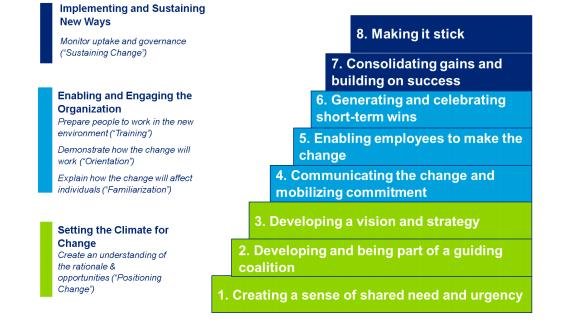Once upon a time, employees were hired for their hands. The workforce represented skilled labor and production. As mechanization and technology advanced, people were hired for their minds, becoming critical thinkers and problem solvers who could find new and better ways of doing work. Now, the prevalence of data and AI has moved the analysis of complex problems into the realm of machines. As a result, we are evolving and recognizing the importance of hiring for heart. Nowhere is heart more critical than in leading change.
Understanding Resistance to Change
Change is a disruption. It can feel like a tornado that rips up the highway you travel along daily. Think of some common types of organizational change: re-thinking core business processes in response to government regulation, uprooting a company and moving to a new physical location, or even replacing a much-loved leader after decades of service. These drastic changes require careful sensemaking and empathy for how the change affects your people. Even smaller changes, such as moving payroll from a bi-weekly schedule to once a month, impact how people manage their lives. It’s a foolhardy leader who announces a change and an implementation plan and expects unquestioning compliance. People need to be a part of the change.
In their book Switch, brothers Chip and Dan Heath liken leading people through change to a person riding an elephant down a path. The person riding is the brain, and he must know where he is going and have a good reason for doing so – but the elephant is the heart, and he must want to move. All the logic in the world won’t create lasting change unless we tap into emotions and motivate ourselves and others.
Trying to overcome resistance to change with information and reasoning can be tempting. Indeed, if people understood the consequences of their behavior, they would make a switch. Unfortunately, most of us know what’s good for us (daily exercise, eight hours of sleep, avoiding processed foods, etc.), and we know the dangers of an unhealthy lifestyle (heart disease, stroke, and osteoarthritis, to name but a few). However, changes in our behaviors and habits will likely not happen until there is a motivating force. A health scare or the birth of a grandchild may persuade us to choose our health, especially when it means being present for the people who depend on us. The same is true for organizations. More information is not always the answer. As the Heaths point out, “Trying to fight inertia and indifference with analytical arguments is like tossing a fire extinguisher to someone drowning. The solution doesn’t match the problem.” Leading change means providing support – not support for why the change is needed, but support for employees as they adapt to the new way.
Kotter’s 8-step Change Management Process
Is your organization going through a major change? Is that change universally accepted as a good move, or does it represent uncertainty and risk? Very few changes are without trade-offs, and a good leader will consider how to win their people’s minds and hearts. Multiple studies report that most organizational change initiatives fail; 70% is the failure rate reported by McKinsey & Company. Optimism and good intentions are not enough, so change experts have developed models for leading change. You may be familiar with Kotter’s 8-step change management process, a methodology created by Harvard Business School professor Dr. John Kotter in 1995. As we examine each of these steps, we can see how heart plays a role:
- Create A Sense of Urgency. This step speaks directly to the ‘elephant’ of our emotions and compels us to act NOW.
- Build A Guiding Coalition. This is a team of people from within the ranks, not senior leaders. These people know how the change impacts others like them and are committed to seeing it succeed.
- Form A Strategic Vision. The leaders point the way to a destination and make others excited to reach it.
- Enlist A Volunteer Army. The key here is commitment at scale – people must want to join and be a part of something bigger than themselves.
- Enable Action by Removing Barriers. Here the leaders recognize obstacles and clear the path by listening, observing, and serving.
- Generate Short-Term Wins. These are the motivators that let team members know they are making progress. What would football be without down markers?
- Sustain Acceleration. Find out what is working well and do more of that. Leaders should recognize achievements and reward efforts.
- Institute Change. This speaks to the heart in terms of identity. We do this because it is who we are.

Emotional Intelligence and Leading Change
The key to successfully implementing these steps is emotional intelligence. Recognizing and understanding emotions in yourself and others helps you manage behaviors and relationships and ultimately build stronger teams. Luckily, emotional intelligence is not just a trait some people are born with but rather a skill that can be practiced and improved. Like many things, it starts at home with an honest reflection on your tendencies. Try practicing better self-awareness by noticing, without judgment, how you routinely react to certain situations. You may see that you always strive to be correct, even when you might benefit from changing your assumptions and considering alternatives. You may automatically become a problem-solver when the problem is a more excellent definition. As you identify your communication patterns, you may uncover blind spots that impede effective communication with others. Test your emotional intelligence with a quiz provided by Great Good Magazine.
One way to improve your emotional intelligence is to prioritize it as a part of your professional development. We highly recommend these courses developed by our partner, Daria Lewandowska. Based out of Poland, Daria is a sociologist who specializes in Gallup’s strengths development, emotional intelligence, leadership, and talent coaching.
Psychological Safety and Leading Change
Also, consider your relationships and what you can do to let others contribute to your change initiatives. Much has been said about psychological safety and its importance in the workplace. Still, its value only seems to grow as we navigate uncertain times and reevaluate our priorities in the workforce.
Psychological Safety is defined as the freedom to speak up confidently on relevant work topics without fear of negative consequences; psychological safety allows teammates to voice concerns and identify strategies for overcoming them. In organizations that stifle dissent or “shoot the messenger,” people will withhold vital information and rein in their commitment. As a leader, you can promote psychological safety by inviting and rewarding feedback. Instead of asking if anyone has questions or concerns, ask, “What am I missing?” when you lay out a plan. Encourage others to identify potential obstacles and ask what they would do to resolve them. Asking the right questions can be more important than providing all the answers and will help you develop real teams of trust.

Get Your Digital Copy of The Leader’s Guide – a roadmap for your leadership journey.
Finally, sometimes you just need some helpful and practical tips you can implement in right away. That is why we have developed The Leader’s Guide. In chapter 13, you will find Kotter’s eight-step leading change process and reasons why people resist change with strategies of how to overcome. Get your free copy of The Leader’s Guide today!
Are you ready to take the first step on your path to success as a leader? Explore our full portfolio of online courses, certificate programs, and more!



